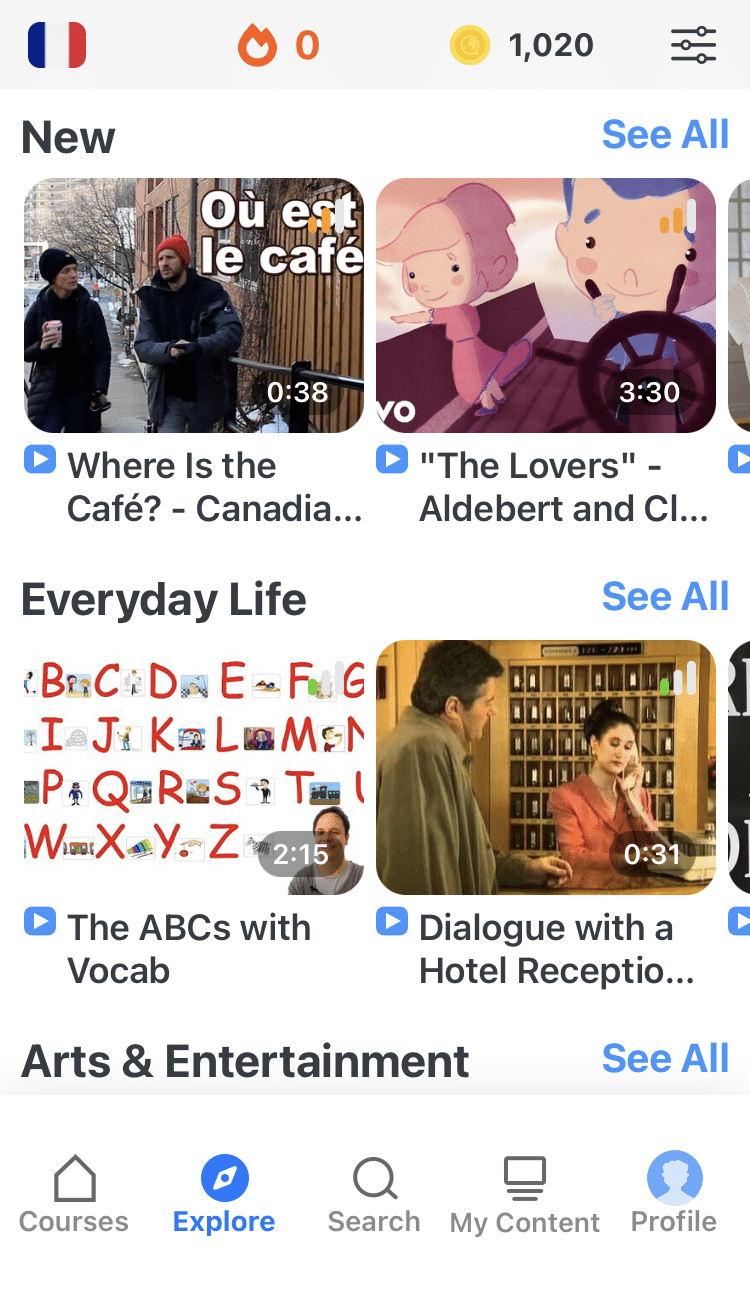
Stem-changing Verbs in French
Conjugation is a fact of French-language life. There isn’t any way around it, and it’s easy to get burned in the process.
That being said, it is, after all, thanks to verb conjugation that we know who’s doing what and can situate their actions in time.
Broadly speaking, French verbs fall into regular and irregular conjugation patterns. However, there are also stem-changing verbs, which is what this article will cover.
Read on to discover six types of stem-changing verbs in French with conjugations and example verbs.
Contents
- What Are French Stem-changing Verbs?
- 6 Types of French Stem-changing Verbs
- How to Practice French Stem-changing Verbs
- And one more thing...
Download: This blog post is available as a convenient and portable PDF that you can take anywhere. Click here to get a copy. (Download)
What Are French Stem-changing Verbs?
Conjugation takes place through the process of isolating the stem, also known as a radical. What’s a stem? For example, the stem of the verb parler (to speak) is parle-.
Stem-changing verbs are the group of -er verbs that have two different stems:
1. One stem for the first person singular (me), second person singular (informal you), third person singular (he, she, formal you) and third person plural (they) conjugations.
2. One stem for the first person plural (we) and second person plural (you all) conjugations.
Stem changes aren’t only limited to the present tense. They also occur in the imperative and the subjunctive, as well as in the future and the conditional. The rules for these stem changes in different tenses are slightly different—and beyond the scope of this post—but it’s important to know that they do occur.
One key thing to know is that if a verb has a stem change in the present tense, then it will have one in the subjunctive as well.
Whew. That may sound complicated but it’s not so bad as long as you stay on your toes (and practice!).
6 Types of French Stem-changing Verbs
There are six types of stem-changing verbs, which are categorized according to the final four letters of the verb.
1. -ayer verbs
Verbs that end in -ayer can undergo an optional stem change in which the y changes to i, except in the nous (we) and vous (you, plural) forms.
Let’s take the verb essayer (to try) as an example. It can either be conjugated as any ole -er verb, like so:
| French | English |
|---|---|
| J'essaye | I try |
| Tu essayes | You try |
| Il/Elle essaye | He/She tries |
| Nous essayons | We try |
| Vous essayez | You all try |
| Ils/elles essayent | They try |
If we apply a stem change, it can be conjugated as follows:
| French | English |
|---|---|
| J'essaie | I try |
| Tu essaies | You try |
| Il/Elle essaie | He/She tries |
| Nous essayons | We try |
| Vous essayez | You all try |
| Ils/Elles essaient | They try |
The stem-changing spelling variation is generally more common than the non-stem-changing spelling variation, although both are considered correct.
Balayer (to sweep), effrayer (to frighten), enrayer (to stop, to halt) and payer (to pay) are some common –ayer verbs that you’re bound to come across.
2. -eler verbs
Unlike -ayer verbs, the stem change is non-negotiable in the case of -eler verbs. The stem change that verbs that end in -eler undergo in the present tense entails the adding of an l in all forms except for nous (we) and vous (you all).
The verb épeler (to spell) is one such verb that follows this pattern:
| French | English |
|---|---|
| J'épelle | I spell |
| Tu épelles | You spell |
| Il/Elle épelle | He/She spells |
| Nous épelons | We spell |
| Vous épelez | You all spell |
| Ils/Elles épéllent | They spell |
Other common verbs that follow this pattern are appeler (to call), rappeler (to call back) and renouveler (to renew).
Exceptions: There are some –eler verbs, such as celer (to conceal, to hide), ciseler (to chisel), démanteler (to dismantle), geler (to freeze) and harceler (to harass) that don’t undergo the above stem change. Rather, they follow the pattern of –e_er verbs (we’ll go over those below in the fourth section).
3. –eter verbs
For many -er verbs that end in -eter, the stem change undergone is the doubling of the t.
The verb projeter (to project) follows this pattern:
| French | English |
|---|---|
| Je projette | I project |
| Tu projettes | You project |
| Il/Elle projette | He/She projects |
| Nous projetons | We project |
| Vous projetez | You all project |
| Ils/Elles projettent | They project |
Other verbs that follow this pattern are feuilleter (to leaf through), hoqueter (to hiccup), jeter (to throw) and rejeter (to reject).
Exceptions: Some -eter verbs that don’t follow the pattern of doubling the t are acheter (to buy), fileter (to thread) and haleter (to pant).
4. -e_er verbs
The little “_” indicates one or more consonants. The stem change that takes place entails changing the e before the consonant to è for all forms except for nous (we) and vous (you all).
Let’s take a look at a few examples, shall we?
Acheter (to buy)
| French | English |
|---|---|
| J'achète | I buy |
| Tu achètes | You buy |
| Il/Elle achète | He/She buys |
| Nous achetons | We buy |
| Vous achetez | You all buy |
| Ils/Elles achètent | They buy |
Amener (to take)
| French | English |
|---|---|
| J'amène | I take |
| Tu amènes | You take |
| Il/Elle amène | He/She takes |
| Nous amenons | We take |
| Vous amenez | You all take |
| Ils/Elles amènent | They take |
Peser (to weigh)
| French | English |
|---|---|
| Je pèse | I weigh |
| Tu pèses | You weigh |
| Il/Elle pèse | He/She weighs |
| Nous pesons | We weigh |
| Vous pesez | You all weigh |
| Ils/Elles pèsent | They weigh |
Some other verbs that undergo this stem change that you’re bound to come across are enlever (to remove), geler (to freeze), lever (to lift, to raise), peler (to peel) and promener (to walk).
5. -é_er verbs
As in the last case, the little “_” stands for a consonant. The stem change that takes place entails changing the é before the consonant to è for all forms except for nous (we) and vous (you all). Sound familiar? Finally, it’s important to note that these stem changes also occur in the imperative and subjunctive.
Let’s take the verb inquiéter (to worry) as an example:
| French | English |
|---|---|
| J'inquiète | I worry |
| Tu inquiètes | You worry |
| Il/Elle inquiète | He/She worries |
| Nous inquiétons | We worry |
| Vous inquiétez | You all worry |
| Ils/Elles inquiètent | They worry |
Some other verbs that undergo this stem change are céder (to cede, to give up), célébrer (to celebrate), espérer (to hope), gérer (to manage), posséder (to possess), préférer (to prefer), refléter (to reflect), répéter (to repeat) and suggérer (to suggest).
6. -oyer and -uyer verbs
For –er verbs that end in -oyer and -uyer alike, the stem change that they undergo in the present tense entails changing the y to an i except in the nous (we) and vous (you all) forms.
Let’s take a look at two examples: Nettoyer (to clean) and appuyer (to press, to lean).
Nettoyer (to clean)
| French | English |
|---|---|
| Je nettoie | I clean |
| Tu nettoies | You clean |
| Il/Elle nettoie | He/She cleans |
| Nous nettoyons | We clean |
| Vous nettoyez | You all clean |
| Ils/Elles nettoient | They clean |
Appuyer (to press, to lean)
| French | English |
|---|---|
| J'appuie | I press/lean |
| Tu appuies | You press/lean |
| Il/Elle appuie | He/She presses/leans |
| Nous appuyons | We press/lean |
| Vous appuyez | You all press/lean |
| Ils/Elles appuient | They press/lean |
Some common -oyer verbs that undergo the same stem change are: broyer (to ground), employer (to employ), envoyer (to send), tutoyer (to use tu) and vouvoyer (to use vous).
Ennuyer (to bore) and essuyer (to wipe) are two common -uyer verbs that undergo the same stem change.
How to Practice French Stem-changing Verbs
- Flashcards. As you probably know by now, flashcards are a great tool (among many others) for committing material to your long-term memory. Check out this flashcard set to get your practice started.
- Immerse yourself in French content. A great way to practice stem-changing verbs in French is by immersing yourself in French content so you can see how they are used in context by native speakers. For example, you could watch French movies or try an immersive language learning program like FluentU.
FluentU takes authentic videos—like music videos, movie trailers, news and inspiring talks—and turns them into personalized language learning lessons.
You can try FluentU for free for 2 weeks. Check out the website or download the iOS app or Android app.
P.S. Click here to take advantage of our current sale! (Expires at the end of this month.)
- Quizzes. Once you feel that said material has been committed to long-term memory, quizzes are a no-nonsense way to make sure that this is really the case. Check out this fill-in-the-blank quiz, this interactive verb conjugation activity, as well as this quiz for starters.
- Conjugation apps. When you’re out and about, a conjugation app is far more useful than a paper copy of “501 French Verbs” (although I highly recommend you check it out when you’re cozied up at home). My absolute favorite is L’Obs’s conjugation app.
Well, there you have it!
Dealing with these verbs is just a matter of keeping ahead of the game.
Learn these six types of French stem-changing verbs and you’ll be prepared to conjugate well.
Download: This blog post is available as a convenient and portable PDF that you can take anywhere. Click here to get a copy. (Download)
And one more thing...
If you like learning French on your own time and from the comfort of your smart device, then I'd be remiss to not tell you about FluentU.
FluentU has a wide variety of great content, like interviews, documentary excerpts and web series, as you can see here:

FluentU brings native French videos with reach. With interactive captions, you can tap on any word to see an image, definition and useful examples.

For example, if you tap on the word "crois," you'll see this:

Practice and reinforce all the vocabulary you've learned in a given video with learn mode. Swipe left or right to see more examples for the word you’re learning, and play the mini-games found in our dynamic flashcards, like "fill in the blank."

All throughout, FluentU tracks the vocabulary that you’re learning and uses this information to give you a totally personalized experience. It gives you extra practice with difficult words—and reminds you when it’s time to review what you’ve learned.
Start using the FluentU website on your computer or tablet or, better yet, download the FluentU app from the iTunes or Google Play store. Click here to take advantage of our current sale! (Expires at the end of this month.)



